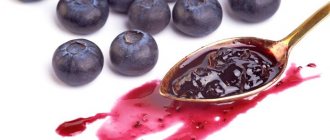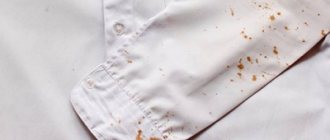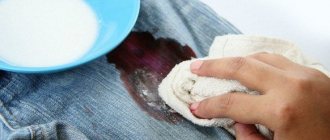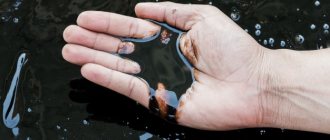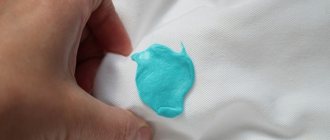0 /5
26.11.2021
163
Rust leaves quite persistent and ingrained stains on fabric, at the sight of which many housewives mentally say goodbye to the stained item. In fact, you can get rid of such traces even if they were left a long time ago, the main thing is to choose the right product and use it, taking into account all precautions. Let's take a closer look at the features of removing rust stains from clothes and the most effective ways to do this.
General recommendations
To successfully get rid of rust marks on clothes, you should follow a number of rules and recommendations:
- Do not put the item off until the next wash. Fresh rust is washed off much faster and more efficiently, so it is recommended to wash a soiled item immediately.
- Avoid contact of the item with water. In this case, there is no need to wash out the stain; this will only make the situation worse. If you do not have the opportunity to clean it, it is better to put the item in a dry place.
- First test the solvent used on an inconspicuous area of the fabric. This way you can make sure that it will not spoil the thing, but will only affect the rust mark.
- or solutions containing them show themselves to be more effective when working with rust They literally eat away at the stain, removing it from the surface of the material.
- When working with aggressive household chemicals or acids, be sure to wear gloves and wash in a well-ventilated area (if we are talking about a bathroom, make sure the ventilation is working properly).
- Do not rub stains in a circular motion. Such attempts to get rid of them will only lead to the opposite effect - the area of tissue damage will increase significantly. Move the brush from the edges to the center.
- Also, before processing the item, be sure to pay attention to the composition of the material from which it is made, and read the label on the back, which contains recommendations for caring for the product. This way you can choose not only an effective, but also a safe way to combat rust.
How to remove an unknown stain
Unfortunately, it is not always possible to determine the nature of the contamination, especially if it is old. In this case, it is best to take the item to the dry cleaner, where specialists will be able to remove almost any stain. If this is not possible (or desired), try removing the unknown trace using laundry soap. This is a universal remedy.
If it doesn’t help, you can move on to more effective formulations - peroxide, ammonia, turpentine, acetone. True, these compounds are not suitable for all types of fabric - for example, acetone can disrupt the fiber structure of silk or wool. In addition, hydrogen peroxide has brightening properties.
In general, you always need to focus on the features of the thing. To do this, it is important to study the information on the label.
What should you not do when removing rust from fabric?
In trying to get rid of traces of rust on clothes, many people make a number of mistakes that only worsen the condition of the item and spoil it. When cleaning rust marks, keep in mind a number of prohibitions:
- Do not try to remove rust mechanically. There is no need to try to rub, scrape, or otherwise physically get rid of the stain. This will only ruin the fabric being treated, but will not clean the stain.
- Do not wash a soiled item in a machine. When in contact with water, the rust stain will only increase, after which it will be much more difficult to get rid of its traces.
- Do not use chlorine-based stain removers when cleaning rust from clothing. They are ineffective and useless in the fight against even fresh traces.
- Do not wash or soak items with rust stains with clean clothing. Despite the fact that the likelihood of the stain spreading in this way is quite low, prolonged contact in a wet state can still lead to damage to the clean fabric.
- Don't rub the mark. When cleaning a rust stain, move from the edges to the center to gradually reduce the area affected by the item.
Before you start cleaning your item, be sure to read the care instructions on the label. If you follow them, you will keep the item in its original condition and safely get rid of rust.
Removing old grease stains from T-shirts
To effectively wash old grease from T-shirts, you should use stronger detergents.
Alcohol and vinegar
First of all, you need to use ammonia, ethyl alcohol and table vinegar.
These products are available and can be found literally at your fingertips. Due to their solvent properties, these liquids can leave old oil stains on light and dark T-shirts.
Alcohol and vinegar can be conveniently applied to the stain using a cotton pad or piece of clean cotton wool, wiping from the edge to the center. Gradually, the fat dissolves and turns into cotton wool, which is regularly replaced with new, soaked liquid. In this way, you can almost completely remove dirt from T-shirts of different colors.
Acetone and solvents
Paint solvents such as white spirit, 646, etc., as well as acetone, are aggressive chemical solvents that can dissolve greasy stains of any age on any fabric, as well as construction paint and foam. Handle them with care as there is a risk of damaging the color and material of the knitwear.
Tip: Test the liquid first on an inconspicuous area of the T-shirt. If the fabric turns white or loses its shape after contact with solvents, rinse the area quickly and thoroughly under running water and avoid further use of solvents.
Turpentine and gasoline
Purified turpentine and gasoline can completely replace solvents, as they have similar properties.
You can use them according to the instructions above.
The downside for some people may be the unpleasant lingering odor that remains after using turpentine and gasoline. To get rid of it, wash the T-shirt with a fragrant detergent.
Questions and answers
What is the first thing to do when you find a trace of rust? Use solvent or acids to remove most of the rust, then wash the item with stain remover or bleach.
Is it possible to soak a soiled item if you don’t have time to wash it?
In no case, contact with water will only increase the stain, which will make it much more difficult to wash off later.
What folk methods are most effective for dealing with rust?
Acids perfectly clean fabric from fresh and stubborn rust stains - this can be lemon juice or acid, vinegar, tartaric or oxalic acid, etc.
How to get rid of a very old rust stain on rough fabric?
Try cleaning it with plumbing cleaners. Since such compounds are designed to remove rust, they often cope with even the most stubborn and stubborn stains on clothing.
Folk remedies
Stain removers act quickly and effectively, but they are not always on hand. You can use folk remedies.
How to wash collars on a white shirt
Over time, white or gray stripes form on the shirt collar, which are very difficult to get rid of. If you don’t have bleach on hand, the following folk remedies can replace it:
- Lemon juice. Rub a slice of lemon onto the dirty stripe on the collar, after 20 minutes rinse under running cold water and wash the shirt.
- Table vinegar. The spice is applied to the stain with a swab, left for half an hour, then washed and the item is put in the washing machine.
- Peroxide. A solution of hydrogen peroxide (3%) is applied to the dirty strip and washed off after 5-10 minutes.
If the shirt has not been worn for a long time, then yellow stains on the collar will not be easy to remove. Experienced housewives suggest trying the following method:
- Prepare a soap solution from grated half a bar of laundry soap and 5 liters of warm water.
- Apply a little whitening toothpaste to the collar and scrub with an old toothbrush.
- Immerse the shirt in the soapy solution for several hours.
- Wash in machine or by hand.
How to Remove White and Brown Stains from a Black T-shirt
Dark things are considered non-staining and practical. But removing stains from black fabric, once they have formed and are visible, is more difficult than from any other. Black dye is often as unstable as red dye. And it loses all its attractiveness with prolonged washing, the use of aggressive agents or hot water.
A common problem is the appearance of whitish stains from deodorant. These traces are formed due to the content of aluminum and/or zinc salts in deodorants. Such stains can be removed using 9% vinegar or citric acid solution. But first you need to make sure that the item is painted with a permanent dye.
Procedure:
- Moisten the contaminated area generously with liquid.
- After 5-10 minutes, rinse the item and put it in the wash.
To remove stubborn stains, the acid exposure time can be increased to 12 hours.
The appearance of brown spots on a black sweater or T-shirt (if it is not dye) is most often due to the fact that the item was painted with a low-quality dye. It fades under the influence of ultraviolet radiation or when washed with powder containing bleaching particles. Such stains cannot be washed off. Only fabric dye will correct the situation.
Traces of fats and oils
Such pollution occurs frequently. If you take action right away, it will not be difficult to deal with the problem:
- It is necessary to immediately fill the area of contamination with fine salt, talcum powder, and tooth powder.
- The bulk of the fat or oil will be absorbed, and all that remains is to wash away the stained area using dishwashing detergent or laundry soap.
Old stains can be cleaned using lighter fluid. Then talc or tooth powder should be poured onto the treated tissue and left for several hours. At the end, the item should be washed with conditioner and air dried (this will remove the smell of gasoline).
Stains from various drinks
Stains from tea, coffee, wine, juice are classified as difficult to remove.
You can deal with them like this:
- cover the fresh trace of the drink with sugar and leave for 1 hour, then wash the item;
- bleach stains on white fabric with lemon juice or hydrogen peroxide;
- clean old stains with a solution of oxalic acid - half a teaspoon per glass of water;
- remove coffee stains with a solution of ammonia;
- Remove traces of coffee or tea on delicate fabrics with heated glycerin;
- Wipe marks from fruit juices with a mixture of vodka and glycerin (in equal proportions);
- Immediately cover fresh wine stains with salt and then wash them with laundry soap;
- Treat old traces of wine with a 5% ammonia solution.
If you cannot cope with the stains, you will have to purchase a stain remover.
Spots of unknown origin
The most difficult thing to remove is contamination of unknown origin. First you need to try washing your soiled clothes in a soapy solution. If this does not help, try substances that help cope with stains of various natures. These are hydrogen peroxide (for white fabrics), ammonia solution, purified gasoline, and nail polish remover. In most cases, pollution gives up.
So, most types of stains can be removed yourself. But it’s better not to put things off for too long: fresh stains are much easier to remove than old ones.
Machine or hand wash
After removing the stain using one of the above methods, the T-shirt should be washed. This can be done either manually or by machine. There is no fundamental difference between them, but in both cases it is necessary to follow a few simple rules:
- sort things by color: white linen is only white, dark linen is dark, and colored things are by color and shade;
- pre-soaking for heavily soiled items;
- Wash again if grease or sweat stains are not removed the first time.
Special stain removers
It is easier to remove long-standing stains with special wide-spectrum stain removers, according to the manufacturers’ instructions.
Antipyatin
The stain remover contains components that have the ability to remove certain types of fresh and old stains:
- bile;
- glycerol;
- salt;
- caustic soda;
- nitrates based on saturated acids.
The product is available in the form of soap. Recommended for washing white and children's laundry.
Removal method:
- moisten the stained area with warm water;
- lather, rub, leave for 15 minutes;
- wash;
- rinse.
Water temperature for washing is up to 55 degrees. Rinse washed items in warm water.
Vanish
For stubborn stains on white and colored items, the use of active oxygen is effective. For cotton fabrics, stains are removed during the washing process by adding 60 grams of Vanish. Dirt from wool and silk fabrics disappears after soaking in bleach for 1 hour in warm water. Wash by hand.
Ace Oxy Magic
Oxygen-based bleach is intended for washing all types of fabrics (colored and white), with the exception of wool and silk, at a temperature of 30 degrees.
Udalix Oxi Ultra
Oxygen stain remover is used for washing clothes and linen with protein, oil, and mineral stains.
Astonish Oxi Plus
Old stains are removed after pre-soaking. A powerful oxidizing agent discolors stains:
- from greenery;
- blood;
- mold;
- red wine;
- milk;
- eggs;
- sauces;
- juices;
- buttered;
- resinous substances.
The product is used for machine and hand washing.
Bos
To remove stubborn stains, the manufacturer offers Bos plus Anti Stain spray. The main component is oxygen, which is able to remove food contamination from chocolate, wine, mayonnaise, milk, eggs. Suitable for all types of fabrics, including wool and synthetics. Not effective against stubborn stains of blood, juice, or wine.
